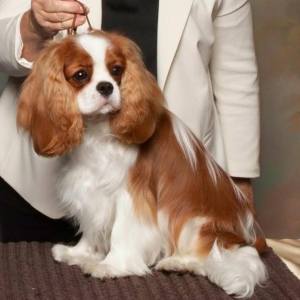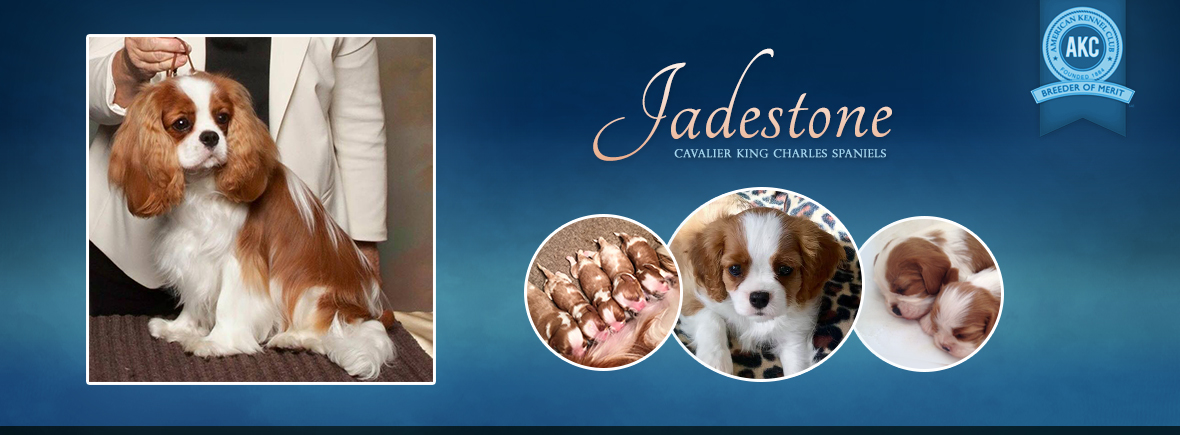
The Cavalier King Charles Spaniel is an active, graceful, well-balanced toy spaniel, very gay and free in action; fearless and sporting in character, yet at the same time gentle and affectionate.
- Lifespan: 9-14 years
- Height: 12-13 inches
- Group: Toy Group
A Cavalier is an even-tempered family dog. The breed is friendly, affectionate, and good with both children and other animals. The breed standard recognizes four colors: Blenheim (chestnut and white), Tricolor (black/white/tan), Black and Tan, and Ruby. The Cavalier King Charles Spaniel of today is the direct descendant of the small Toy Spaniels seen in so many of the pictures of the 16th, 17th, and 18th centuries.
“Cavaliers are the best of two worlds, combining the gentle attentiveness of a toy breed with the verve and athleticism of a sporting spaniel.” – AKC
History
Toy Spaniels were quite common as companion pets of the Court in Tudor times, but in England, it was under the Stuarts that they were given the royal title of King Charles Spaniels. History tells us that King Charles II was seldom seen without two or three or more at his heels.

During the reign of King Charles II, the period was called the Restoration period or the Cavalier period; hence the name Cavalier was added to the name, and they became known as the King Charles Spaniels. They have been recorded in paintings and tapestries for centuries together with the aristocratic families who enjoyed their loyal companionship.
Today’s Cavalier is directly modeled on its royal ancestors, but this did not happen without the effort of an American fancier, Roswell Eldridge. Mr. Eldridge traveled to England in the early 1920s, hoping to buy two spaniels.
He was unsuccessful, finding a diversity of type and none of the “old-type”, particularly the head type he desired. Employing Yankee ingenuity and determination, Roswell offered prizes of twenty-five pounds to the best male and best female of the “old-type” exhibited at Crufts each year. The motivator worked; interest was generated among breeders to revive the original spaniel.

In 1952, the first Cavaliers were sent to America, and a national breed club was formed soon after, but because of the small numbers of Cavaliers, they did not gain full breed recognition for 40 years. January 1, 1996, saw the Cavalier King Charles Spaniel enter the American Kennel Club competition as the 140th recognized breed.
The Cavalier King Charles Spaniel breed came over to the USA in 1952, and the first club was established in 1954. Around this time, the breed rallied to be recognized by the AKC but was unsuccessful due to low breed numbers. Finally, in January of 1996, the Cavalier became the 140th AKC (American Kennel Club) recognized dog breed!
Since the breed was first recognized, the Cavalier has grown and prospered in popularity. They are particularly popular in the United Kingdom, being in the top 10 most desirable breeds.
Colors
- Blenheim
- Blenheim is possible the most popular cavalier color consisting of twocolors; chestnut and white.
- Tricolor
- The Tri color consist of three colors; Black, tan and white. The amount of each color can vary.
- Black and Tan
- Black and tan cavaliers were the apple of King Charles eye. He favored Black and Tan colored cavaliers over all other color variations.
- Ruby
- Ruby cavaliers are meant to be solid ruby color. They can have white but is favored to not have white in the show ring. When breeding a breeder would try to breed a solid Ruby and solid Black & Tan to achieve no white or little white. If both parents do not have white then the pups should not have white.

Health
I am a Cavalier enthusiast who cares about the health of Cavaliers and their future progeny. I am committed to the preservation of the Cavalier Breed and its health; therefore, I follow the recommendation testing of OFA (Orthopedic Foundation For Animals) for the Cavalier breed. If we are to have these endearing little Toy Spaniels to love and cherish for many years and generations to come, we must all do our part to attend annual health clinics and only breed from health tested individuals.
Inherited Diseases in Cavaliers as listed by the AKC, CKCSC Parent Club and CHIC certification;
- Mitral Valve Disease (MVD)
- Syringomyelia
- Hip Dysplasia
- Patella Luxation
- Retinal Dysplasia and Additional Eye Diseases
What is CHIC certification?
The Canine Health Information Center, also known as CHIC, is a centralized canine health database jointly sponsored by the AKC/Canine Health Foundation (AKC/CHF) and the Orthopedic Foundation for Animals (OFA). To qualify for CHIC, Cavaliers must be screened for Hip Dysplasia (OFA, Penn HIP or OVC), Cardiac (OFA – exam performed by Board Certified Cardiologist. Recommended Annually.), Patellar Luxation (OFA), and have a CERF eye examination. Although it is not required, it is recommended that an initial CERF exam be performed at 8-12 weeks, with a follow up exam once the dog reaches 12 months of age, annual exams thereafter until age 5, and every other year until age 9.
Do mixed-breed dog have fewer genetic diseases?
The findings from surveys performed by the late George A. Padgett, DVM, Veterinary Pathologist & Professor Emeritus at the College of Veterinary Medicine of Michigan State University and author of Control of Canine Genetic Diseases, indicate that mixed-breed dogs have more genetic diseases than purebred dogs. There are 215 known diseases in mixed-breed dogs, with 71 percent of them having defective genes. The idea that a mixed-breed dog has fewer genetic diseases than a purebred is a misconception.
Links
- The Key Element Of Preservation Breeding
- Parent Club Health Statement
- AKC Official Standard of the Cavalier King Charles Spaniel
- CKCSC, USA Official Standard of the Cavalier King Charles Spaniel
- CKCSC, UK Official Standard of the Cavalier King Charles
- “AKC – The Cavalier King Charles Spaniel”
- Poisonous Plants
Gallery

